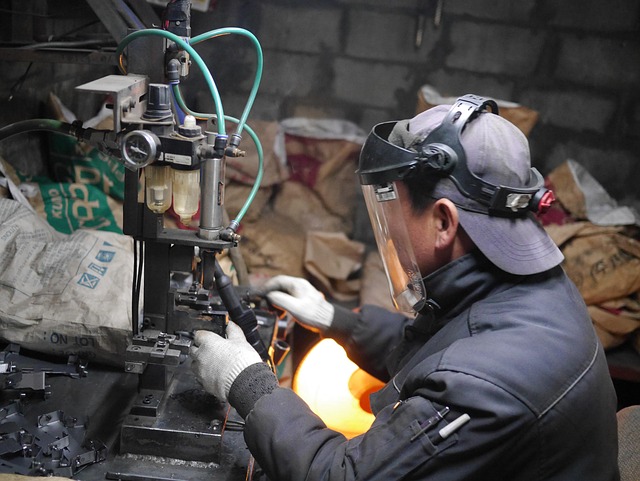
Category: Exploring Oregons Criminal Court Process
Exploring Oregon’s Criminal Court Process: A Comprehensive Guide
Introduction
In the intricate web of legal systems worldwide, Oregon’s approach to criminal court processes stands as a beacon of innovation and reform. This article delves into the multifaceted world of Oregon’s criminal justice system, exploring its unique process, historical evolution, and global impact. By examining various aspects, from economic influences to technological advancements, we aim to provide an insightful perspective on what makes Oregon’s criminal court process noteworthy and how it shapes the lives of its citizens.
Understanding Oregon’s Criminal Court Process: A Deep Dive
Definition: Oregon’s criminal court process refers to the series of legal procedures followed when an individual is accused of a crime within the state. It encompasses arrest, prosecution, defense, adjudication, sentencing, and post-conviction remedies, all governed by Oregon Revised Statutes (ORS) and constitutional provisions.
Core Components:
-
Arrest: Law enforcement officers have the authority to make arrests for alleged crimes. Upon arrest, individuals are read their Miranda rights, ensuring due process protections.
-
Booking and Charges: Arrested persons are booked into the local jail, where their personal information is recorded. They are then formally charged with specific criminal offenses outlined in ORS.
-
Preliminary Hearing: In many cases, a judge conducts a preliminary hearing to determine if there is sufficient evidence to bound the case over to circuit court. This ensures that accusations are well-founded.
-
Trial and Adjudication: The defendant stands trial before a judge or jury, presenting evidence, calling witnesses, and arguing their case. After deliberations, the jury or judge renders a verdict, either of guilt or innocence.
-
Sentencing: If found guilty, the court imposes an appropriate sentence based on the crime’s severity and relevant sentencing guidelines. Sentences may include probation, fines, community service, or imprisonment.
-
Appeals and Post-Conviction Relief: Defendants have the right to appeal their convictions and seek post-conviction relief if they believe legal errors occurred during the process. Oregon’s courts handle these appeals, ensuring fairness and adherence to the law.
Historical Context:
Oregon’s criminal court system has evolved over time, reflecting societal changes and legal reforms. The state’s early years saw a focus on harsh punishment and isolation, with institutions like the Oregon State Penitentiary housing both inmates and the mentally ill. However, the 20th century brought about significant reforms, emphasizing rehabilitation, community reintegration, and restorative justice. Today, Oregon’s system aims to balance public safety, accountability, and fairness while addressing root causes of criminal behavior.
Significance:
-
Public Safety and Justice: The process ensures that individuals accused of crimes receive a fair trial, protecting both the rights of the accused and the interests of victims and society at large.
-
Rehabilitation and Recidivism: Oregon’s system incorporates rehabilitation programs, aiming to reduce recidivism rates and empower ex-offenders with skills for successful reintegration into society.
-
Community Involvement: The process encourages community participation through victim advocacy groups, restorative justice practices, and community-based sentencing options.
Global Impact and Trends
Oregon’s criminal court process has garnered international recognition for its innovative approaches, influencing legal systems worldwide. Here are some key global trends and influences:
-
Restorative Justice: Oregon’s emphasis on restorative justice practices, such as mediation and community service, has inspired other jurisdictions to adopt similar models, aiming to heal harms and rebuild communities.
-
Diverse Sentencing Options: The state’s flexibility in sentencing, including alternatives to incarceration like drug courts and mental health courts, has been adopted by many countries seeking to reduce prison populations while addressing specific needs.
-
Technology Integration: Oregon’s early adoption of technology, such as online court access and digital evidence management systems, has set a global standard for efficiency and accessibility in the criminal justice system.
Regional Variations:
Different regions worldwide adapt Oregon’s process to suit their unique cultural, legal, and social contexts:
| Region | Key Adaptations |
|---|---|
| Europe | Emphasis on human rights and due process, with robust public defender systems and strict bail regulations. |
| Asia | Incorporation of traditional restorative practices alongside modern criminal justice methods, focusing on community harmony. |
| Latin America | Community-based approaches to crime prevention and rehabilitation, influenced by social work and community organizing traditions. |
Economic Considerations
The criminal court process has significant economic implications, impacting various sectors within the state:
-
Market Dynamics: Legal services, including defense attorneys, private investigators, and legal documentation firms, thrive in Oregon, contributing to a robust service industry.
-
Investment Patterns: The stability and effectiveness of Oregon’s criminal justice system attract investments in real estate, business, and tourism, fostering economic growth.
-
Cost-Benefit Analysis: Studies suggest that investing in restorative justice programs and alternative sentencing can lead to significant long-term cost savings for the state by reducing recidivism rates.
-
Justice Reinvestment: Oregon’s approach to criminal justice reform aligns with national trends of “justice reinvestment,” where funds previously allocated to incarceration are redirected towards community-based programs and services.
Technological Advancements
Technology plays a pivotal role in modernizing Oregon’s criminal court process, enhancing efficiency, accessibility, and security:
-
Online Court Access: Oregon’s online court system allows public access to case information, schedules, and documents, promoting transparency and saving resources.
-
Digital Evidence Management: Advanced digital systems streamline the management of evidence, ensuring its integrity and accessibility for all parties involved in a case.
-
Video Conferencing: Remote hearings and court appearances via video conferencing have become common, particularly during the COVID-19 pandemic, ensuring continuity in legal proceedings.
-
Forensic Technology: Advancements in forensic science, including DNA analysis and digital forensics, assist investigators in solving crimes and provide robust evidence in court.
Future Potential:
-
Artificial Intelligence (AI): AI has the potential to revolutionize case prediction, risk assessment, and legal research, offering efficient tools for judges, lawyers, and policymakers.
-
Blockchain Technology: Secure record-keeping and data sharing capabilities of blockchain can enhance transparency and efficiency in managing criminal records and court documents.
-
Mobile Court Services: Expanding mobile court services through technology enables justice to reach remote or underserved communities, promoting accessibility.
Policy and Regulation
Oregon’s criminal court process is governed by a comprehensive legal framework, ensuring fairness, consistency, and accountability:
-
Oregon Revised Statutes (ORS): The ORS provides the legal basis for criminal procedure, outlining crimes, penalties, and procedural rules.
-
Constitutional Protections: The Oregon Constitution guarantees various civil liberties, including due process, equal protection, and the right to a fair trial, which are upheld throughout the criminal court process.
-
Statutory Initiatives: Legislated initiatives, such as the Criminal Justice Reform Act of 2019, focus on reducing prison populations, improving mental health support, and promoting restorative justice practices.
-
Court Rules: The Oregon Supreme Court adopts rules governing procedure, evidence, and ethics, ensuring a structured and fair legal process.
-
Policing Policies: Department of Public Safety Standards and Practices (DPSSP) regulate law enforcement conduct, guaranteeing professional and accountable policing practices.
Challenges and Criticisms
Despite its innovative approach, Oregon’s criminal court process faces several challenges:
-
Resource Allocation: Insufficient funding for defense services, mental health courts, and restorative justice programs can hinder their effectiveness and accessibility.
-
Recidivism Rates: While Oregon has made strides in reducing recidivism, certain demographics, such as youth and individuals with mental health issues, continue to face higher reoffending risks.
-
Court Backlogs: Overburdened courts, particularly at the lower levels, lead to prolonged wait times for trials, impacting both defendants’ rights and the overall efficiency of the system.
Strategies for Improvement:
-
Increased Funding: Allocating more resources to support defense services, alternative sentencing programs, and community reintegration initiatives can enhance the effectiveness of the criminal justice system.
-
Diverse Programming: Expanding evidence-based programs for at-risk youth, veterans, and individuals with mental health or substance use disorders can address underlying issues contributing to crime.
-
Court Efficiency: Implementing technology solutions and streamlining procedures can reduce court backlogs, ensuring timely adjudication and respect for due process rights.
Case Studies: Successful Applications
1. Youth Justice Reform in Oregon
Oregon’s youth justice system has undergone significant reforms, focusing on restorative practices and community-based interventions. The “Youth Rehabilitation Act” aims to divert youth from secure confinement by providing alternatives like community supervision, residential treatment, and intensive home-based services. This approach has led to reduced reoffending rates and positive outcomes for young offenders, demonstrating the success of evidence-based youth justice models.
2. Mental Health Court Programs
Oregon’s mental health courts address the unique needs of individuals with severe mental illnesses who have come into contact with the criminal justice system. These specialized courts provide access to psychiatric treatment, medication management, and supportive services while offering a structured legal framework. Case studies show improved recovery rates, reduced recidivism, and enhanced public safety outcomes for participants in these programs.
3. Restorative Justice in Practice
In a high-profile case in Portland, Oregon, a community-based restorative justice program successfully mediated between a youth offender and the victim’s family. The process involved open dialogue, accountability, and reparative actions, leading to healing for all parties involved. This example illustrates how restorative practices can transform the criminal justice system by emphasizing reconciliation and community restoration.
Future Prospects: Emerging Trends and Opportunities
Oregon’s criminal court process is poised for further growth and evolution, driven by technological advancements and societal changes:
-
AI-Assisted Legal Services: AI chatbots and virtual assistants can provide basic legal information and assistance to pro se litigants, increasing accessibility and efficiency.
-
Prevention and Early Intervention: Expanding prevention programs targeting at-risk youth and focusing on early intervention strategies for individuals with mental health issues can reduce crime rates.
-
Diverse Sentencing Options: Continuously refining alternative sentencing approaches, such as drug treatment courts and community service, will ensure a balanced approach to justice and public safety.
-
Global Collaboration: Oregon can further collaborate internationally to share best practices, engage in research, and develop innovative solutions to global challenges in criminal justice.
Conclusion: Navigating the Future of Criminal Justice
Oregon’s criminal court process serves as a testament to the state’s commitment to fairness, innovation, and community-centric justice. By embracing technological advancements, implementing restorative practices, and fostering collaboration, Oregon continues to set a benchmark for criminal justice systems worldwide. As the field evolves, the lessons learned from Oregon’s approach will undoubtedly influence and shape the future of criminal court processes globally, ensuring that justice remains accessible, equitable, and effective.
FAQ Section: Addressing Common Concerns
Q: How does Oregon’s criminal court process ensure due process rights for defendants?
A: Due process is guaranteed by the U.S. Constitution and Oregon state laws. Defendants have the right to legal representation, a fair trial, cross-examination of witnesses, and protection from self-incrimination. The judicial system ensures these rights are respected throughout the process.
Q: What role does technology play in improving public safety through Oregon’s criminal court process?
A: Technology enhances efficiency by streamlining court procedures, enabling secure digital evidence management, and facilitating remote hearings. It also supports predictive analytics for risk assessment and improves access to legal services, ultimately strengthening public safety measures.
Q: How do restorative justice practices benefit victims and offenders?
A: Restorative justice focuses on healing and reconciliation by bringing together victims, offenders, and community members. It empowers victims to share their experiences and promotes accountability among offenders, fostering a sense of responsibility and personal growth.
Q: Can you explain Oregon’s approach to sentencing for first-time offenders?
A: Oregon employs a range of options for first-time offenders, including diversion programs, probation, community service, and fine/fee alternatives. The goal is to avoid incarceration where appropriate, provide education and support, and reduce recidivism rates.
Q: How does Oregon address the mental health needs of individuals within the criminal justice system?
A: Oregon has implemented specialized mental health courts and programs that provide access to psychiatric treatment, medication management, and supportive services. These initiatives aim to improve outcomes for individuals with severe mental illnesses who come into contact with the criminal justice system.









